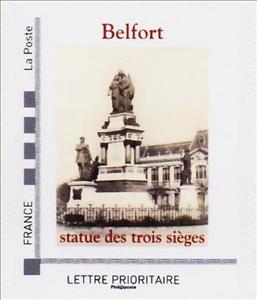Stamp: Belfort, Statue des trois Sieges (France 2016)
Belfort, Statue des trois Sieges (France 2016)
01 January (France ) within release CNEP Collector Sheets goes into circulation Stamp Belfort, Statue des trois Sieges face value 20 Gram
| Stamp Belfort, Statue des trois Sieges in catalogues | |
|---|---|
| Yvert et Tellier: | Yt: FR CNEP71/1 |
Stamp is square format.
Also in the issue CNEP Collector Sheets:
- Souvenir Sheet - Autumn Philatelic Show Paris 2016 Gare de Lyon Locomotive CC face value Lettre;
- Stamp - Belfort, Statue des trois Sieges face value 20;
- Stamp - Locomotive CC-7107 World Record face value Lettre;
- Souvenir Sheet - Spring Philatelic Show Belfort 2016. Statue des trois Sieges face value 20;
|
Data entry completed
46%
|
|
|---|---|
| Stamp Belfort, Statue des trois Sieges in digits | |
| Country: | France |
| Date: | 2016-01-01 |
| Emission: | Personalized - Official |
| Format: | Stamp |
| Face Value: | 20 Gram |
Stamp Belfort, Statue des trois Sieges it reflects the thematic directions:
A fortification (also called a fort, fortress, fastness, or stronghold) is a military construction designed for the defense of territories in warfare, and is used to establish rule in a region during peacetime. The term is derived from Latin fortis ("strong") and facere ("to make").
Logos is a term used in Western philosophy, psychology and rhetoric, as well as religion (notably Christianity); among its connotations is that of a rational form of discourse that relies on inductive and deductive reasoning.
A map is a symbolic depiction emphasizing relationships between elements of some space, such as objects, regions, or themes. Many maps are static, fixed to paper or some other durable medium, while others are dynamic or interactive. Although most commonly used to depict geography, maps may represent any space, real or imagined, without regard to context or scale, such as in brain mapping, DNA mapping, or computer network topology mapping. The space being mapped may be two dimensional, such as the surface of the earth, three dimensional, such as the interior of the earth, or even more abstract spaces of any dimension, such as arise in modeling phenomena having many independent variables. Although the earliest maps known are of the heavens, geographic maps of territory have a very long tradition and exist from ancient times. The word "map" comes from the medieval Latin Mappa mundi, wherein mappa meant napkin or cloth and mundi the world. Thus, "map" became the shortened term referring to a two-dimensional representation of the surface of the world.
A monument is a type of structure that was explicitly created to commemorate a person or event, or which has become relevant to a social group as a part of their remembrance of historic times or cultural heritage, due to its artistic, historical, political, technical or architectural importance. Examples of monuments include statues, (war) memorials, historical buildings, archaeological sites, and cultural assets. If there is a public interest in its preservation, a monument can for example be listed as a UNESCO World Heritage Site. The Palgrave Encyclopedia of Cultural Heritage and Conflict gives the next definition of monument:
A statue is a free-standing sculpture in which the realistic, full-length figures of persons or animals are carved or cast in a durable material such as wood, metal or stone. Typical statues are life-sized or close to life-size. A sculpture that represents persons or animals in full figure, but that is small enough to lift and carry is a statuette or figurine, whilst those that are more than twice life-size are regarded as colossal statues.




